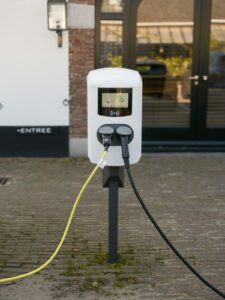
Home / EV Charging News / Electrification of Fleets: Reducing Emissions and Operating Costs
Large fleets of vehicles, such as those used for ride-sharing or delivery services, are responsible for a significant amount of greenhouse gas emissions. However, by electrifying these fleets, businesses can not only reduce their environmental impact but also benefit from lower operating costs. In this article, we will explore the benefits of fleet electrification and the challenges that businesses may face.
One of the primary benefits of fleet electrification is the reduction of emissions. Electric vehicles (EVs) produce zero emissions during operation, which means they can significantly reduce a business’s carbon footprint. According to a study by the International Council on Clean Transportation, electrification of ride-hailing services could reduce global CO2 emissions by up to 1.5 gigatons by 2050.
Another benefit of fleet electrification is lower operating costs. EVs have lower maintenance costs, as they have fewer moving parts than traditional internal combustion engine (ICE) vehicles. Additionally, the cost of electricity is generally lower than gasoline or diesel, which can result in significant savings over time.
Fleet electrification can also improve a business’s corporate social responsibility (CSR) by demonstrating a commitment to sustainable practices. This can lead to improved customer perception, increased brand loyalty, and positive media coverage.
Businesses can overcome the high upfront costs of fleet electrification by taking advantage of financial incentives and grants. Many governments and organizations offer financial support to businesses that switch to EVs, which can help offset the initial investment.
To overcome the challenge of limited availability of charging infrastructure, businesses must engage in strategic planning. This can involve identifying locations for charging stations, installing their own charging infrastructure, and working with local governments to increase the availability of public charging stations.
Finally, businesses can overcome the challenge of limited driving range and battery life by investing in the latest battery technology. As battery technology improves, EVs will be able to travel further on a single charge, reducing range anxiety and increasing their usefulness for fleet operators.
Fleet electrification is no longer a distant dream but an attainable goal for businesses of all sizes. The benefits of electrification, including reduced emissions and lower operating costs, are too significant to ignore.
To reap the benefits of fleet electrification, businesses must act now. By investing in EVs and charging infrastructure, businesses can reduce their carbon footprint, lower their operating costs, and improve their corporate social responsibility. As technology continues to improve, the future of fleets is electric.
$2,890.00 Original price was: $2,890.00.$2,790.00Current price is: $2,790.00.
$3,950.00 Original price was: $3,950.00.$3,450.00Current price is: $3,450.00.
$1,650.00 Original price was: $1,650.00.$1,590.00Current price is: $1,590.00.
$2,290.00 Original price was: $2,290.00.$2,150.00Current price is: $2,150.00.
$1,290.00 Original price was: $1,290.00.$799.00Current price is: $799.00.

Your Power Management Partner for Over 25 Years Future Generations Depend on Our Decisions Today ™
2024 © All rights reserved by CyberSwitching